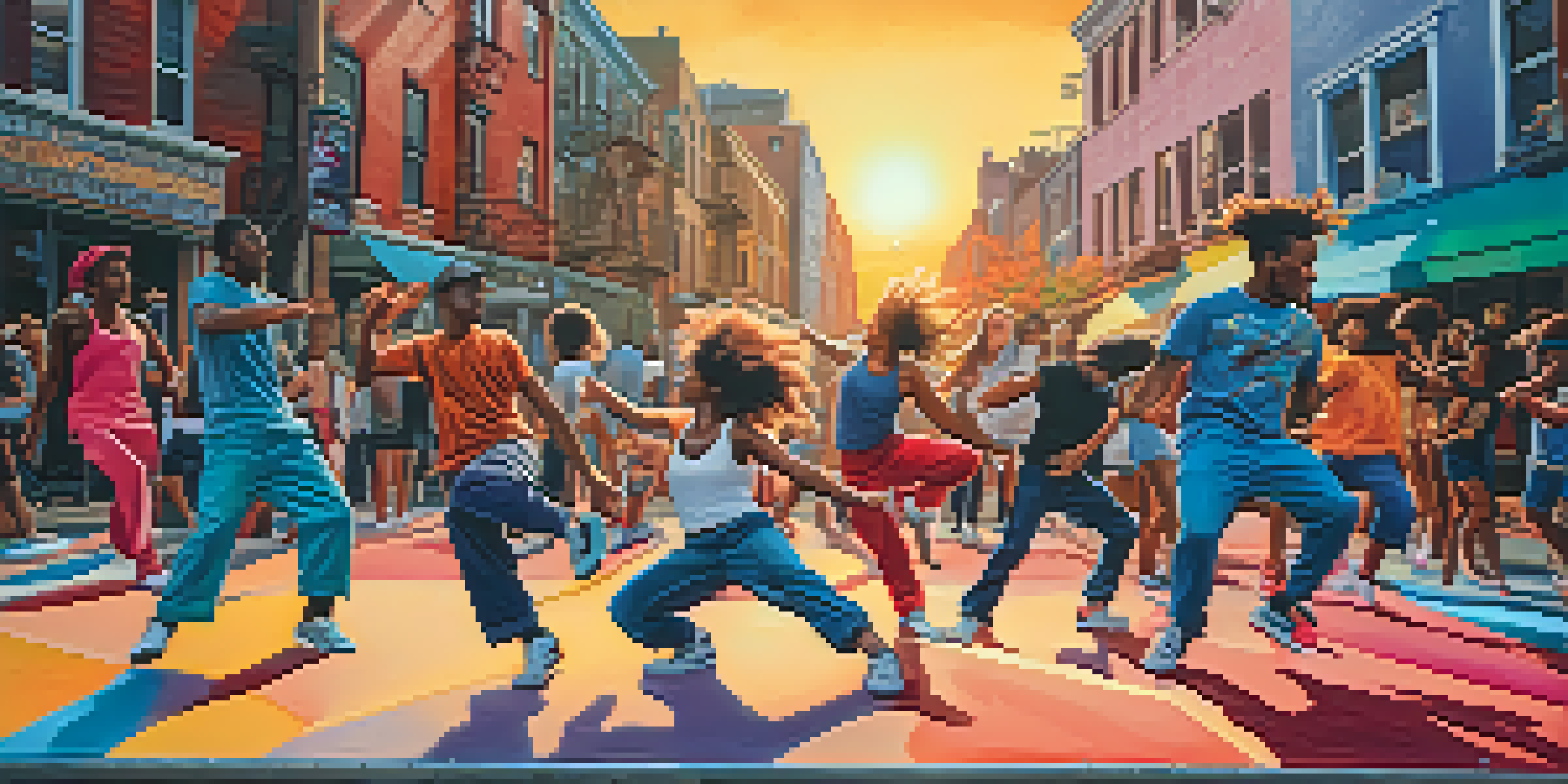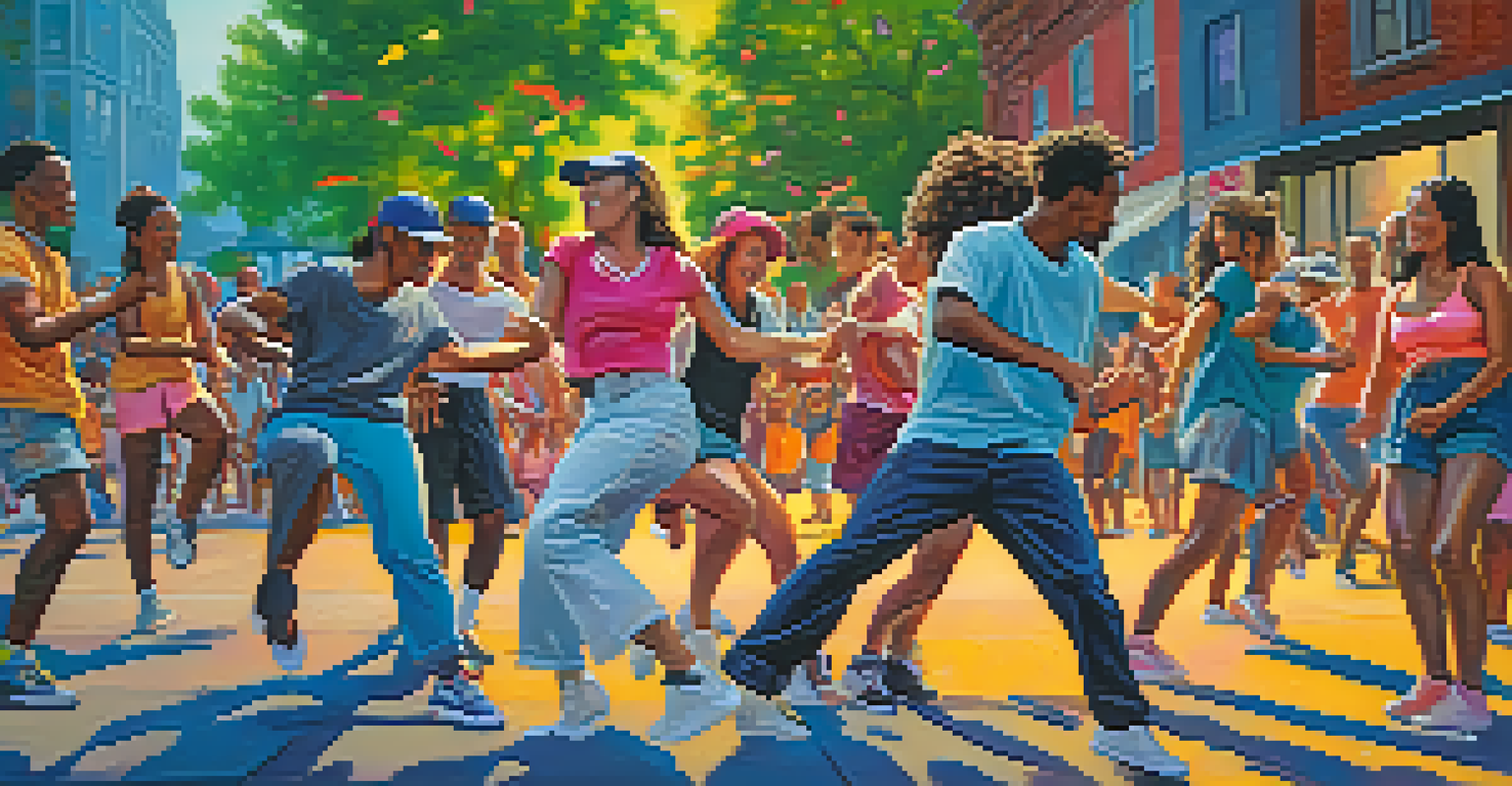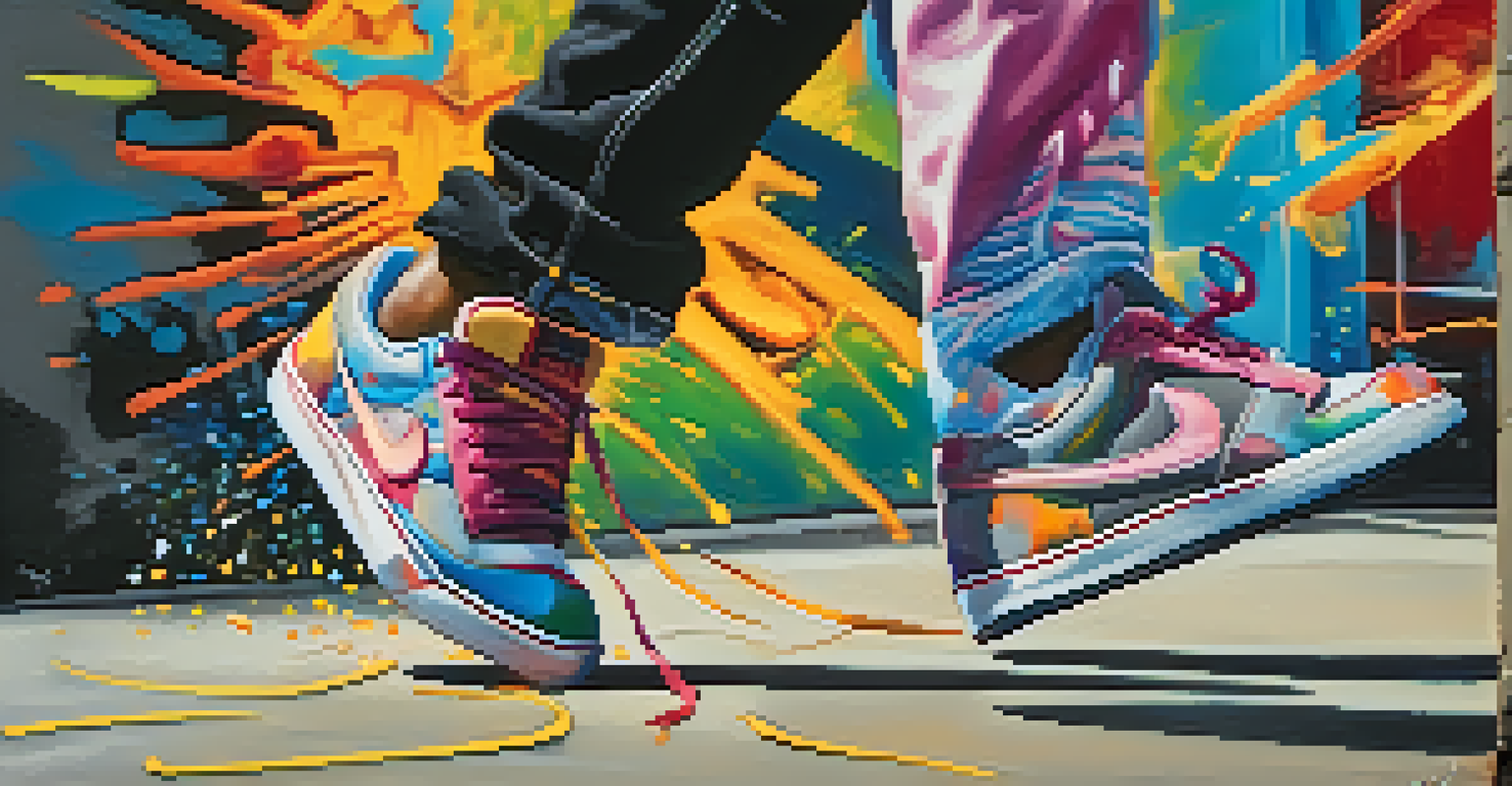Street Dance Origins: An Exploration of Urban Cultural Movement

The Birth of Street Dance in Urban America
Street dance, often synonymous with urban culture, has its roots deeply embedded in the vibrant streets of America during the late 20th century. Emerging primarily from the African American and Latino communities, styles like breakdancing, locking, and popping began to flourish in the 1970s. These dances weren't just movements; they were powerful expressions of identity, creativity, and community amidst social challenges.
Dance is the hidden language of the soul.
Think of the early street dancers as modern-day poets, using their bodies to tell stories about their lives and the world around them. As young people gathered in parks and on street corners, they created a culture that celebrated individuality and collective spirit. This grassroots movement gave rise to dance battles, where dancers would showcase their skills and creativity, fostering a sense of friendly competition.
This era set the stage for street dance to evolve, drawing influences from various genres, including funk, disco, and even martial arts. The blend of styles made street dance a unique form of expression that resonated with many, paving the way for its eventual prominence in global pop culture.
Key Styles and Their Unique Characteristics
Street dance is not a one-size-fits-all genre; it encompasses a variety of styles, each with its unique flair and history. Breakdancing, or b-boying, is perhaps the most recognized form, characterized by dynamic movements like spins, flips, and freezes. Meanwhile, locking and popping, rooted in funk music, focus on quick, robotic movements and sudden stops, showcasing precision and rhythm.

Each style tells its own story and reflects the culture from which it emerged. For instance, the fluidity of popping can be seen as a response to the mechanical world, while the acrobatics of breakdancing reflect the creativity of urban youth in navigating societal constraints. This diversity not only enriches the street dance scene but also attracts a wide audience, drawing in enthusiasts from all walks of life.
Street Dance: A Cultural Expression
Street dance emerged as a powerful form of expression rooted in the African American and Latino communities, reflecting identity and creativity amidst social challenges.
Moreover, these styles often intermingle, leading to innovative fusions that keep the art form fresh and exciting. Dancers are constantly experimenting, blending techniques and influences, which keeps street dance alive and evolving in the ever-changing urban landscape.
The Role of Hip-Hop Culture in Street Dance
Hip-hop culture is intrinsically linked to street dance, serving as both a backdrop and a catalyst for its growth. As hip-hop music began to rise in popularity during the late 1970s and 1980s, so too did the dance styles that accompanied it. This synergy created a powerful cultural movement that transcended geographic boundaries and brought people together through rhythm and movement.
The best thing about being a dancer is that you can express yourself through movement.
The influence of hip-hop is evident in how dancers express themselves, often using their routines to comment on social issues, personal struggles, and community pride. For example, many dancers incorporate elements of storytelling into their performances, making their movements a form of social commentary. This connection to hip-hop culture not only enriches the dance itself but also emphasizes its role in advocating for social change.
As hip-hop evolved, so did street dance, with new styles emerging that reflect contemporary societal trends. The ongoing relationship between hip-hop and street dance ensures that both continue to inspire and influence each other, creating a vibrant and dynamic cultural landscape.
Street Dance: A Global Phenomenon
What started as a grassroots movement in urban America has transformed into a global phenomenon, with street dance influencing cultures around the world. From Europe to Asia, local communities have embraced street dance, adapting styles to reflect their own cultural identities. This globalization has led to a rich tapestry of dance forms, each infused with local flavors and traditions.
For example, in France, the dance style known as 'waacking' has gained popularity, incorporating elements of fashion and performance art. Similarly, in Japan, street dance has melded with traditional styles to create unique forms like 'popping' that celebrate both heritage and modernity. This blending of influences showcases the universal appeal of street dance, making it a truly global art form.
Global Influence of Street Dance
What began as a grassroots movement in urban America has transformed into a global phenomenon, with diverse communities adapting styles to reflect their unique cultural identities.
Moreover, international competitions and festivals have emerged, uniting dancers from diverse backgrounds to celebrate their shared love for street dance. These events not only foster camaraderie but also create opportunities for cultural exchange, further solidifying street dance as a vital part of the global cultural landscape.
The Impact of Media on Street Dance Evolution
The rise of media, particularly television and social media, has played a significant role in shaping the evolution of street dance. Shows like 'Soul Train' and 'America's Best Dance Crew' brought street dance into mainstream consciousness, showcasing talented dancers and innovative choreographies. This exposure not only popularized street dance but also inspired countless individuals to take up dancing themselves.
In today's digital age, platforms like YouTube and TikTok have further propelled street dance into the spotlight, allowing dancers to share their moves with a global audience. Viral challenges and dance trends have emerged, creating a new generation of dancers who can learn and showcase their skills from the comfort of their homes. This accessibility has democratized street dance, making it easier for anyone to join the movement.
However, this increased visibility comes with its challenges, as the commercialization of street dance can sometimes overshadow its roots. It's essential to recognize and honor the cultural significance of street dance while embracing its evolution in the digital landscape, ensuring that the original spirit of creativity and community remains intact.
Street Dance and Social Activism
Street dance has always served as a powerful medium for social activism, allowing dancers to voice their opinions and advocate for change. Many dancers use their art to address pressing societal issues such as racism, inequality, and youth empowerment. Through their performances, they can raise awareness and inspire action, making dance a potent tool for social transformation.
For instance, some groups organize dance events that double as fundraisers for various causes, merging creativity with philanthropy. These events not only showcase talent but also create a sense of community and solidarity among participants. By leveraging the popularity of street dance, these activists effectively engage audiences in meaningful conversations about social justice.
Street Dance as Social Activism
Dancers use street dance as a medium for social activism, addressing issues like racism and inequality while fostering community and inclusivity.
Additionally, the collaborative nature of street dance fosters a sense of belonging and inclusivity, offering a safe space for individuals to express themselves. Whether through workshops or community performances, street dance encourages participation from diverse backgrounds, highlighting the importance of unity in addressing social challenges.
The Future of Street Dance: Trends and Innovations
As street dance continues to evolve, new trends and innovations are emerging that keep the art form fresh and exciting. One notable trend is the fusion of street dance with other genres, such as contemporary and ballet, creating unique hybrid styles. This blending not only showcases the versatility of street dance but also challenges traditional notions of dance, pushing the boundaries of creativity.
Moreover, technology is playing an increasingly significant role in shaping the future of street dance. Virtual reality and augmented reality experiences are becoming more common, allowing dancers to explore new dimensions of movement and performance. These advancements open up a world of possibilities, enabling dancers to experiment with their routines in ways previously unimaginable.

As street dance continues to adapt to the changing cultural landscape, it remains rooted in its core values of creativity, community, and self-expression. The future looks bright for street dance, as it continues to inspire and connect people across the globe, proving that the rhythm of the streets is here to stay.